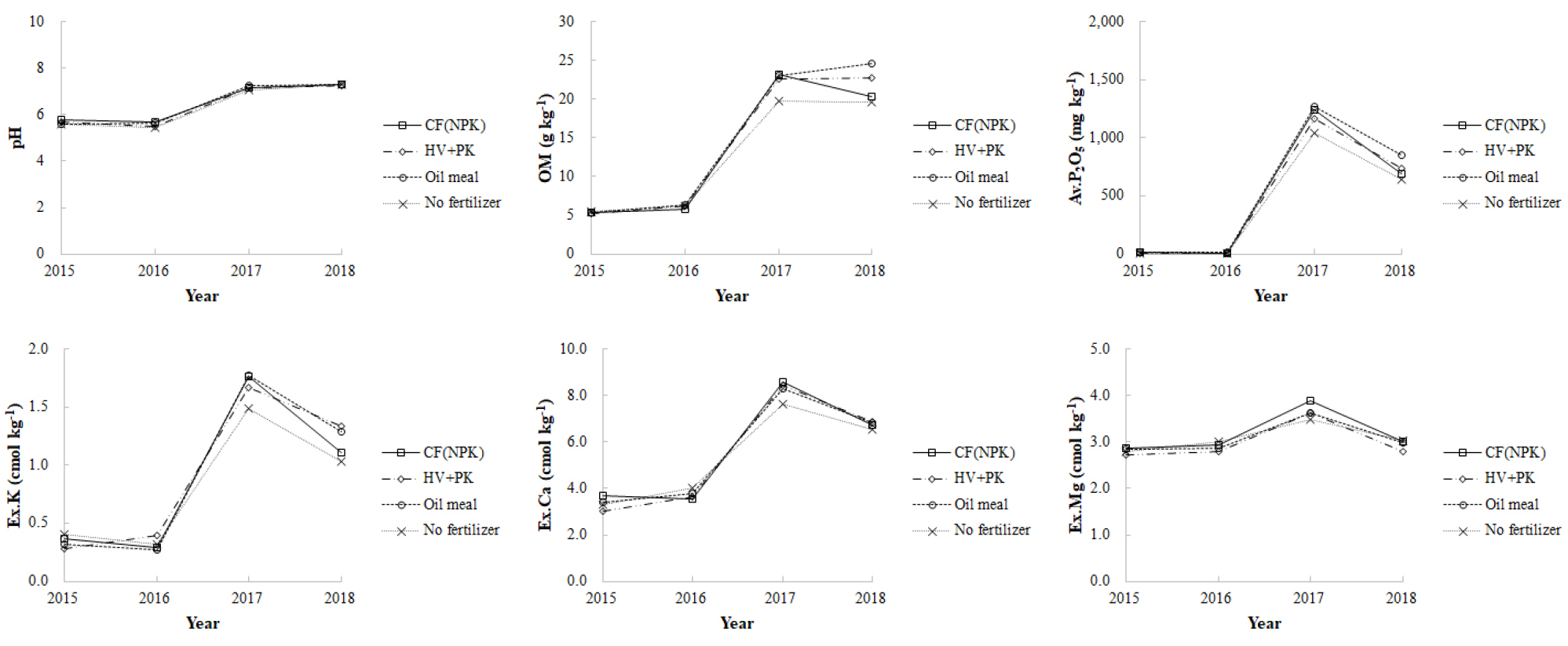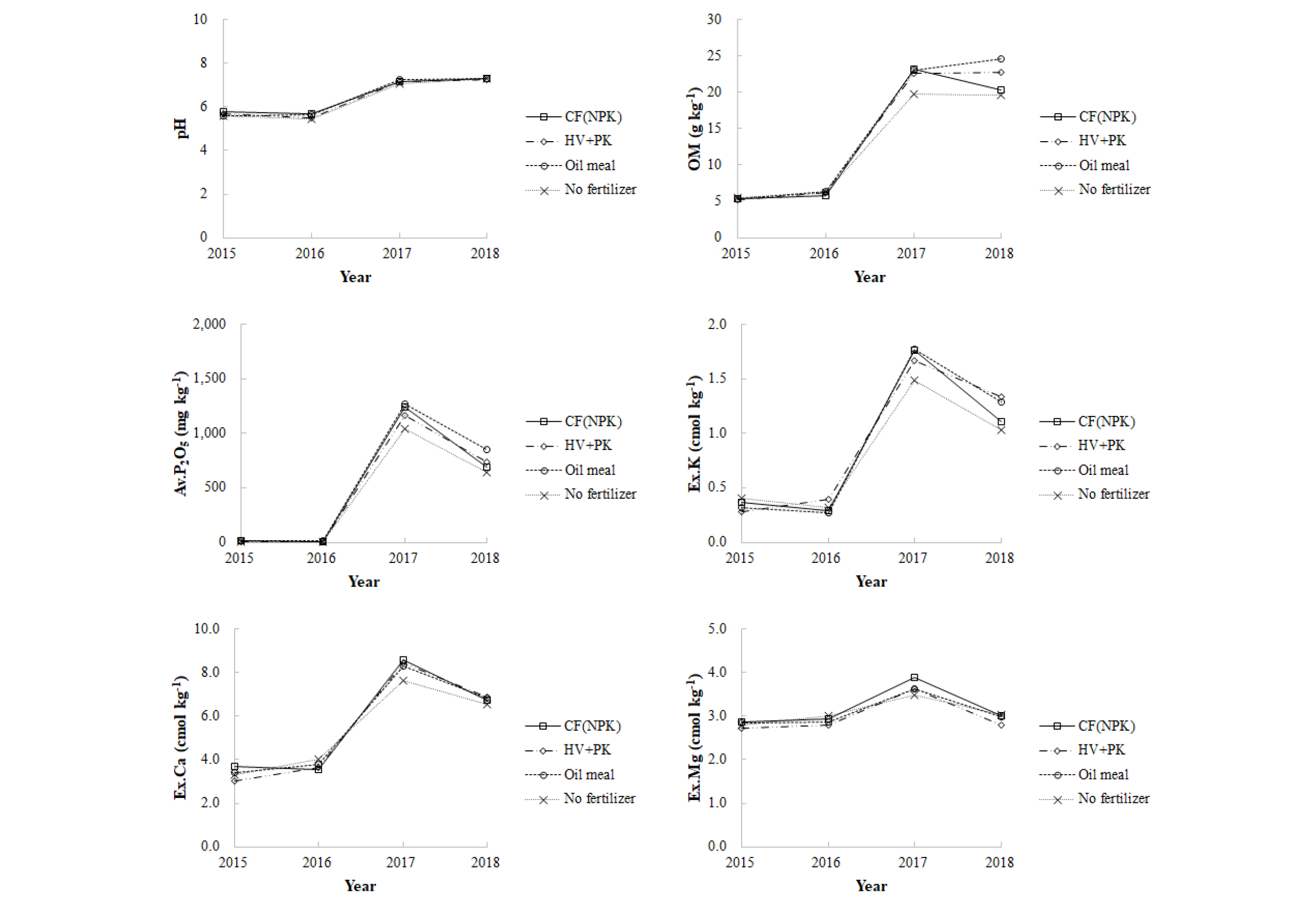Introduction
Soil nutrient management determines fruit quality and productivity, by affecting soil fertility and sustainability. The problem is that over-application does not always result in corresponding increases in nutrient supply (Hammermeister et al., 2006). Also, excessive nitrogen (N) applications can increase leaching losses and water contamination (Atucha et al., 2011). Moreover, excessive N application increases growth and leaf N content, but negatively affects both fruit coloring and quality (Komamura et al., 2000). Therefore, agricultural management practices focused on a reduced impact on the agroecosystem, mainly with regard to biological processes, are promising techniques for sustainable agriculture (Homma et al., 2012). Still, however, it is unclear what is the best management of soil nutrient in newly established apple orchard. The aim of this study was to assess the influence of recommended fertilizer application (RFA) and nutrient management practices on soil chemical properties and leaf mineral content in low fertility clayey apple orchard.
Materials and Methods
Experimental site and treatment details
This study was carried out at experimental plots for long-term application (4 × 4 m) in National Institute of Horticultural and Herbal Science (NIHHS) research field, located in Wanju, Korea. The plots were separated by a concrete wall about 1.5 meter deep to avoid mobilization of mineral nutrients between the plots. Initial soil chemical properties and fertilizer treatments to assess the effect of nutrient management practices in ‘Hongro’/M.9 apple orchard are described in Table 1 and 2, respectively. Four treatments were applied in the experimental plots in a randomized complete block design with three replications per treatment. The treatments were as follows: chemical fertilizer (NPK), castor oil meal, hairy vetch (Vicia villosa L.) + PK, and no fertilizer treatment. Fertilizer application for comparing the effects followed 『Guideline for recommendation of fertilizer application in crops』 (NAAS, 2017). At the end of the second year, all experimental plots received excess livestock manure compost at the rate of 120 ton ha-1 to improve soil fertility of apple orchard and to imitate the condition of farmland soil. ‘Hongro’/M.9 apple tree seedling was planted in each plot with 2 × 1.5 m distance in 2017. For chemical analysis, rhizosphere soil samples were collected in the depth of 5 - 20 cm by soil auger in late July. Healthy and fully expanded leaves were taken from the middle of the shoot at the beginning of August. Then, the leaf samples were dried at 70℃ in a drying oven for two weeks after rinsing with distilled water. Finally, the samples were finely ground by using a blender.
Table 1. Initial soil chemical properties used in this study.
| pH | OM | Av.P2O5 | Exch. cation | ||
| K | Ca | Mg | |||
| 1:5 | g kg-1 | mg kg-1 | -------------------------- cmolc kg-1 -------------------------- | ||
| 5.8 | 4.0 | 3.67 | 0.22 | 3.73 | 3.48 |
Table 2. Fertilizer treatments to assess the effect of nutrient management practices in ‘Hongro’/M.9 apple orchard.
| Treatment† | N | P2O5 | K2O |
| -------------------------- kg ha-1 -------------------------- | |||
| CF(NPK) | 20 | 10 | 10 |
| Oil meal | 20 | 9.8 | 9.5 |
| HV(+ PK) | - | 10 | 10 |
| No fertilizer | - | - | - |
Soil analysis
Chemical analysis of each soil sample was conducted according to Methods of soil chemical analysis (NIAST, 2000). For determination of soil pH, air-dried soil samples were mixed with deionized water in 1:5 ratio (soil:water), and the pH of the clear supernatant was measured using pH meter (Orion VERSA STAR, Thermo fisher scientific, USA). Soil organic matter content was measured by Walkley-Black method, and soil available phosphate content was determined according to the method of Lancaster. For determination of soil exchangeable cations (K, Ca, and Mg), air-dried soil samples were extracted with 1 N ammonium acetate solution (soil and solution ratio was 1:10) for 30 minutes, and the concentration of the extract was determined by inductively coupled plasma optical emission spectrometry (ICP-OES).
Results and Discussion
There were no significant differences between nutrient sources on soil chemical properties (Fig. 1), indicating that oil meal and leguminous cover crops could be effectively used instead of chemical fertilizer to meet nutrient requirement of apple tree for sustainable fruit production. previous studies have emphasized the importance of leguminous plants as N sources in organic crop production (Drinkwater et al., 1998; Muchanga et al., 2017) because legumes form root nodules and symbiotic N-fixation occurred inside. Also, the application of organic fertilizers is an environment-friendly approach to reduce the use of chemical fertilizers, improving soil quality and crop yield (Selvakumar et al., 2018). Soil organic matter and nutrient availability were sharply increased after excess application of livestock manure compost (Fig. 1.). Edmeades (2003) also pointed out that excessive accumulation of some nutrients, particularly P and N, can arise from the long-term use of manures, because the ratio of nutrients in manures is different from the ratio of nutrients removed by common crops, relative to the use of fertilizers. RFA was effective in reducing excessive soil mineral nutrients, while it was not sufficient to increase essential soil nutrients into optimum range under low fertility condition. Soil available phosphate and exchangeable cations effectively decreased over the time, except soil pH and organic matter content for 0 to 15 cm depth (Fig. 1.). The results also provided evidence that nutrient management using organic resources is more effective on potassium (K) uptake of apple tree from the soil (Table 3). Castor oil meal and hairy vetch treatments showed higher K content in the leaves. High K returns from sod clippings have previously been reported (Neilsen and Hogue, 1985).
Table 3. Effect of nutrient sources on leaf mineral content of ‘Hongro’/M.9 apple tree in early August.
‡Mean separation within columns by Fisher's LSD test at P ≤ 0.05.
Conclusion
In this study, we confirmed that oil meal and hairy vetch treatments can be effective nutrient sources to replace the use of chemical fertilizer. RFA without additional organic material showed gradual decrease in soil nutrient content. Therefore, sufficient supply of organic resources is recommended to increase soil chemical properties into optimum range in newly established apple orchard under low fertility condition.






